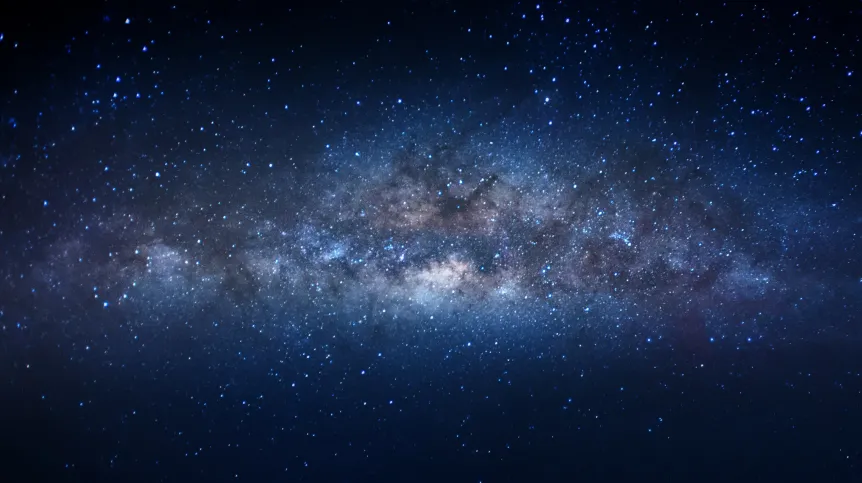
Thanks to the Gaia Observatory, the European Southern Observatory's telescope and other ground-based instruments, scientists have tracked down a record-breaking black hole in our galaxy. Polish astronomers from the Astronomical Observatory of the University of Warsaw took part in the research.
The vast majority of the dozens of known stellar-mass black holes are found in binary systems with stars. These systems emit X-rays, which is related to the loss of material by the star as it is sucked out by the black hole. However, if the black hole does not have such a star nearby, we do not observe any radiation. It is then difficult to find such a dormant black hole.
Scientists from the Gaia space observatory still managed to do it. The third object of this type (a dormant black hole) has been discovered, and it is a record-breaking one in the entire galaxy.
Interestingly, the discovery was accidental; it was made while validating data for the next Gaia mission catalogue. Due to the importance of the discovery and the fact that the publication of the catalogue is planned for 2025 at the earliest, it was decided to publish the results of analyses based on preliminary data earlier.
The scientists analysed the behaviour of an old giant star in the constellation Aquila, located 1,926 light-years from Earth. Based on its orbital motion, it was determined that it was in a binary system with a dormant black hole with a very high mass, estimated to be 33 times greater than the mass of the Sun. It was named Gaia BH3.
Stellar-mass black holes in the Milky Way: Gaia BH1, Cygus X-1, and Gaia BH3, whose masses are 10, 21, and 33 times that of the Sun, respectively. Image credit: ESO/M. Kornmesser)
This result is a record among stellar-mass black holes in the Milky Way. The previous record holder was the black hole in the X-ray binary system Cygnus X-1, with a mass about 20 times that of the Sun. The typical mass of stellar-mass black holes in our galaxy is about 10 solar masses.
Dr. Pasquale Panuzzo from the Paris Observatory (France), who led the research, pointed out that a scientist makes this type of discovery once in a lifetime.
'At thirty times the mass of the Sun, we see results typical of measurements of the masses of very distant black holes observed by gravitational wave experiments. Gaia's measurements constitute the first irrefutable evidence of the existence of such heavy black holes,’ says Professor Łukasz Wyrzykowski from the Astronomical Observatory of the University of Warsaw, who has been a member of the Gaia team since 2008 and belongs to the Black Hole Task Force.
Astronomers now face a difficult task: to explain the origins of black holes as large as Gaia BH3.
According to mainstream theories, as massive stars evolve, they lose much of their material due to strong stellar winds and the ejection of some material during supernova explosions. What is left of the star's core shrinks and becomes a black hole or a neutron star (depending on the mass). It is very difficult to explain a remnant large enough to produce a black hole with a mass as high as 33 times the mass of the Sun.
The star orbiting Gaia BH3 is also interesting. It orbits the black hole at a distance 16 times the Earth-Sun distance, with a period of 11.6 years. The star is a giant, formed in the first 2 billion years after the Big Bang. Back then, the Milky Way was just forming. The star contains very few elements heavier than hydrogen and helium (called metals in astronomical terminology), and since stars in binary systems usually have the same composition, this suggests that the star from which the black hole was born was also low in metals.
'It is surprising that the chemical composition of the companion is similar to that found in old, metal-poor stars in the Galaxy,’ says Dr. Milena Ratajczak from the Astronomical Observatory of the University of Warsaw, a member of the Gaia consortium.
This is the first confirmation of the concept that the high-mass black holes observed in gravitational wave experiments were created by the collapse of primordial massive stars poor in heavy elements. Such objects may have evolved differently than the massive stars present in the Milky Way today.
Gaia is a space observatory of the European Space Agency (ESA). Its main task is to measure the distances to many stars in order to prepare a 3D map of the Milky Way.
To confirm the discovery, the researchers used data from ground-based observatories: the UVES spectrograph on the VLT telescope in Chile (European Southern Observatory), the HERMES spectrograph on the Mercator Telescope on La Palma in Spain (managed by KU Leuven in Belgium, in cooperation with the Observatory of the University of Geneva in Switzerland), the SOPHIE spectrograph at the Haute-Provence Observatory in France (managed by OSU Institut Pythéas).
The research results were published in Astronomy & Astrophysics.
PAP - Science in Poland
cza/ agt/ kap/
tr. RL













